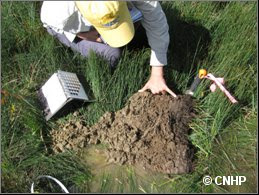
CNHP Wetland Ecologists recently completed work on a three year project assessing the condition of wetlands in the North Platte River Basin. The project was carried out collaboratively with Colorado Parks and Wildlife (CPW)’s Wetland Wildlife Conservation Program and with CPW GIS Analysts. The final report, “North Platte River Basin Wetland Profile and Condition Assessment,” is now available on our Reports page.
The report summarizes findings for the four primary project objectives:
- Compiling existing spatial data on wetlands in the North Platte River Basin to develop a wetland profile;
- Conducting a statistically valid, field-based survey of wetland condition in the basin;
- Modeling the distribution of wetland condition throughout the basin using collected field data and additional spatial data on potential stressors; and
- Determining metrics to measuring key habitat features for priority waterfowl species.
To create the wetland profile, a wetlands had to be digitally mapped for the entire basin. At the outset of the project, National Wetland Inventory (NWI) data was available for less than 10% of the basin, so it was up to CPW and CNHP to map the rest. The completed dataset was used to summarize wetland acreage and type in a number of different ways. There are over 131,000 acres of wetlands in the North Platte Basin, with the majority (77%) being freshwater herbaceous wetlands, with shrub wetlands being the second most common (20%).
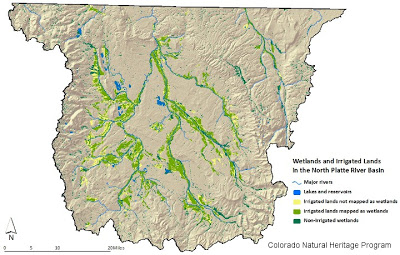 |
| Mapped wetlands in the North Platte Basin. (click to enlarge) |
To assess condition of wetlands in the basin, 95 randomly selected wetland sites were visited in the field and surveyed for 1) Landscape Context, 2) Biotic Condition, 3) Hydrologic condition, and 4) Physiochemical Condition. Scores were produced for each site visited and then extrapolated to estimate wetland condition of all non-irrigated wetland acres. A predictive model of wetland condition was also developed to predict the condition of wetlands not visited in the field. The results of this project provide a baseline assessment of wetland quantity and condition and will inform conservation and watershed protection.
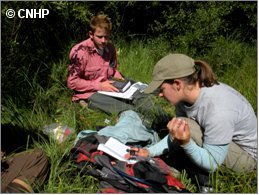 |
| Erick Carlson and Laurie Gilligan sampling wetlands for the project. |
Condition of sampled sites was assessed using the Floristic Quality Assessment, Ecological Integrity Assessment (EIA), and Vegetation Index of Biotic Integrity methods. Extrapolated results indicate that 34% of all wetland acres in the basin would receive an overall EIA rank of A (excellent!), 48% would receive a B, and 17% would receive a C. Across all methods, trends clearly indicate that wetlands in the North Platte River Basin are overall still in very good condition.
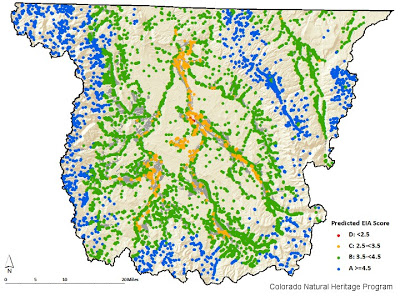 |
| Ecological Integrity Assessment scores applied to wetlands across the basin. |
A statewide Level 1 GIS-based Landscape Integrity Model for wetlands was applied to the North Platte River Basin. Results from the model show that although only 10% of the total basin area falls within the severe stress category, 27% of the wetland acres fall within the severe stress category and an additional 50% fall within the high stress category. Higher stress wetlands are located in the valleys where human activities have altered the landscape.
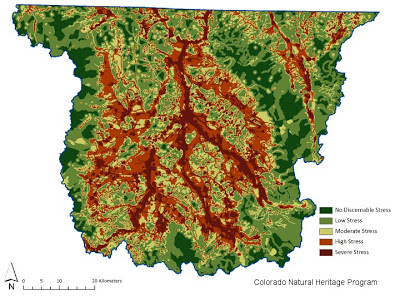 |
| Wetland Landscape Integrity model. Areas of anthropogenic stress (red) correlate well to EIA scores < A. |
Habitat features potentially important to waterfowl were identified by CPW Avian Biologists and a crosswalk between the habitat features and NWI codes was developed. Based on this crosswalk, almost all (90%) of the wetlands in the basin are types important to waterfowl.




